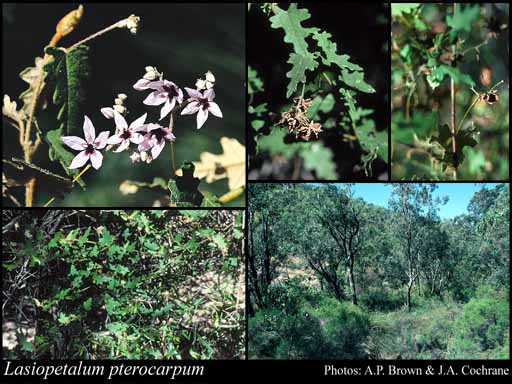- Reference
- Nuytsia 16:177-179, Figs 1-2, 4 (2006)
- Conservation Code
-
Threatened
A taxon name retains its ‘Threatened’ status until a new name has been officially endorsed and appears in the Gazettal Notice.
- Naturalised Status
- Native to Western Australia
- Name Status
- Current
Open, multi-stemmed shrub (with distinctly winged fruit), to 1.2 m high. Fl. pink, Aug to Dec. Dark red-brown loam or clayey sand over granite. On sloping banks near creeklines.

Scientific Description
Shrub, with hairy stems. Leaves 30-40 mm long, 10-40 mm wide, tripartitely lobed or irregularly lobed, simply (once-)lobed or complexly (twice-)lobed; margins crenate; hairy, with stellate hairswith scales absent, Sessile glands absent; stipules apparently absent, even from youngest leaves. Perianth of two whorls but the corolla reduced to small scales or tiny lobes at the base of the ovary. Pedicel present, 4-4.5 mm long; indumentum present, with stellate hairs present, with scales absent. Epicalyx (extra segments or 'bracteoles' immediately below the calyx) present, 2.5-6 mm long, the lobes free, indumentum present, stellate hairs presentwith scales absent, Sessile glands absent. Calyx pink, 4.5-7.5 mm long, the lobes fused less than half their length, Sessile glands absent, simple hairs (without tubercle bases) absent, stellate hairs present, tubercle-based simple hairs absent, gland-tipped hairs absent, scales absent, Terminal appendages absent, number of ribs absent. Corolla glabrous. Indumentum (outside) Sessile glands absent. Stamens five, free and inserted at the base of the ovary; filaments present, 0.1-0.2 mm long; anthers 1.5-2 mm long, indumentum absent (anthers glabrous). Staminodes absent, appendages absent. Ovary hairs or scales present, simple hairs absent, stellate hairs present, gland-tipped hairs absent; style 1, with a lobed or capitate stigma, 3.4-3.6 mm long, with one style branches or lobes, hairy for most of length, wing absent. Flowering time August, September, October, November or December. Distribution Botanical Province South-West, IBRA Bioregion Jarrah Forest. Conservation Code Threatened (T).
Distribution
- IBRA Regions
- Jarrah Forest.
- IBRA Subregions
- Northern Jarrah Forest.
- Local Government Areas (LGAs)
- Serpentine-Jarrahdale.
Nuytsia Journal Articles
Lasiopetalum pterocarpum (Malvaceae s.l.: Lasiopetaleae), a new and and rare species from south-west Western Australia
SHEPHERD, K.A., BENNETT, ELEANOR M., WILKINS, C.F. AND SAGE, L.W., Nuytsia 16 (1): 175–181 (2006)